Albania is not a country that frequently pops on many people’s European travel itinerary. Its way off the Euro Rail grid and it’s one of a small bunch of European countries that isn’t yet a member of the European Union. But this small country located at the bottom west corner of the Western Balkans is a rewarding, authentic and educational experience.
My first taste of Albania was in fact via the newly independent country of Kosovo, which became independent in 2008. In Kosovo at least 90% of the population is Albanian. From the small Montenegrin mountain town of Berane, I boarded a battered bus to the Kosovan town of Peja. I didn’t expect to encounter any significant art of note in this town, but I was delightfully surprised. On a late afternoon stroll through the town, I stumbled upon the Peja Arts Gallery; a large ground floor space with a number of striking paintings by the artist Isa Alimusaj.
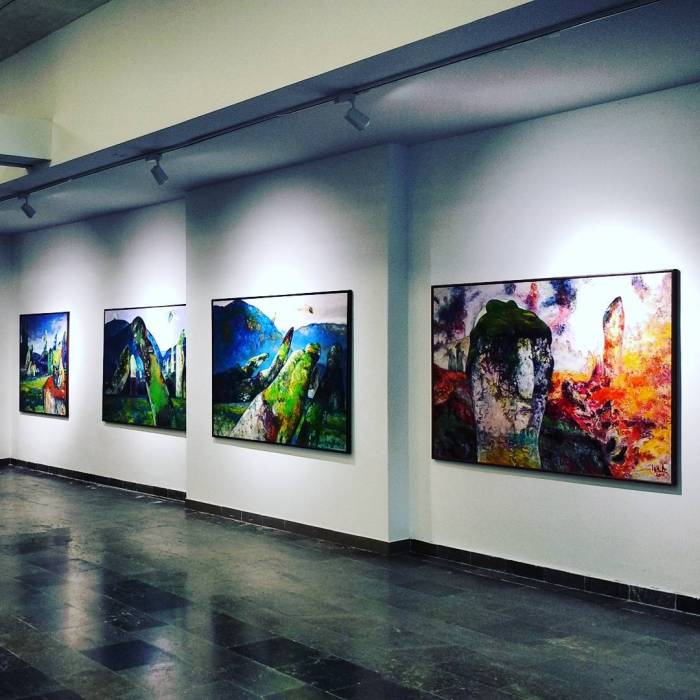
Isa Alimusaj solo exhibition at the Peja Arts Gallery
Alimusaj is a notable Kosovan artist who has exhibited his work extensively in the Kosovo region since the 1970s with occasional exhibitions in Serbia, Albania, Macedonia and even Poland. His paintings are vivid and hallucionary dreamscapes; plains of raw and visceral emotions. I could namecheck Munch, Dali or Bosch, but Alimusaj’s style is his own. His perceptions, vision and created worlds are only his and no one else’s. I look at these monumental paintings and think what a hit they would be exhibited in a top-notch gallery in London, New York or Paris. It’s a crime that they are hidden from most of the world.

Isa Alimusaj
On my second day in Peja, I chance upon an art studio close to the old Ottoman style Bazaar of the town. Little did I know that the studio in fact was Alimusaj’s. Stacks of his sublime paintings were crammed on top of one another in a small room. Alimusaj himself was in a smaller adjacent room painting. When he recognised me I tried to strike up a conversation. He didn’t speak any English only Albanian and some German. In my substandard German I complemented him on his paintings and told him how much I loved his current exhibition.
A few kilometres outside of Peja town is a beautiful old terracotta-red Serbian Orthodox monastery called the Patriachate of Pec. The jewels of this monastery are the painted 13th century frescoes inside. Even after all this time, the paintings are very potent and alive. I am particularly transfixed on a faded ceiling fresco where the areas of deterioration accidently create a powerful and apocalyptic effect in the blue sky; as if Nikola Tesla entered the scene with his earth shattering Tesla coil. It is unwittingly modern.

13th century fresco from the Patriarchate of Pec monastery
In the Kosovan capital of Pristina, I visit the National Gallery of Kosovo. Opposite the gallery is the National Library of Kosovo; an off the scales futurist-retro style juggernaut of a building so out of sight it makes Antoni Gaudi’s architectural designs look like a row of non-descript Barratt homes. The library was designed in 1982, when Kosovo and most of its neighbouring countries where all once part of former Yugoslavia, by the Croatian architect Andrija Mutnjakovic.
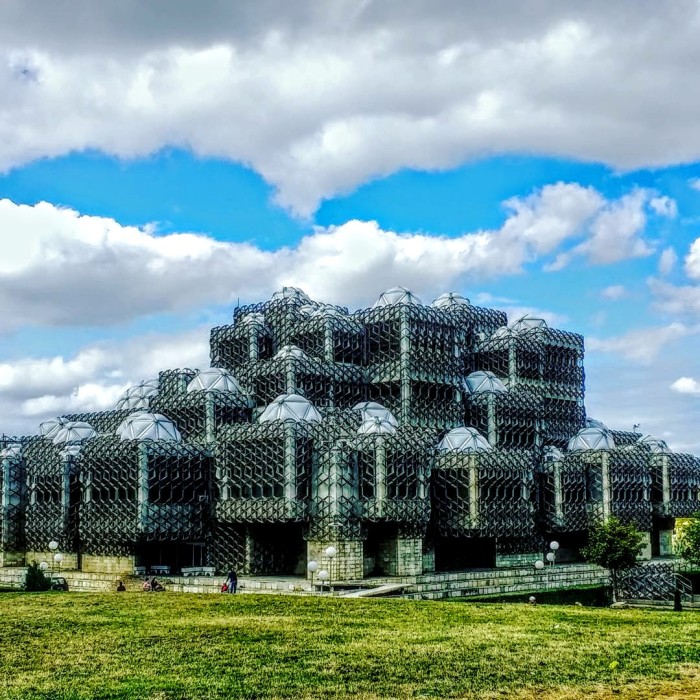
National Library of Kosovo
At the National Gallery there was a solo exhibition on display entitled ‘Groan’ by the artist Zake Prelvukaj. Prelvukaj is a mixed-media artist. There are experimental paintings, photography and video installations on display. Her paintings are expressive, introspective and primal with elements of tribal art from sub Saharan Africa. On the top level floor of the gallery, there are two video pieces by Prelvukaj; one of which entitled Blood-Feud-Vengeance features the artist with her hands covered in blood.

Works by Zake Prelvukaj at the Kosova National Art Gallery
From Kosovo I make my first trip to Albania to the northern town Shkodra, where the Marubi National Museum Of Photography is located. This museum has more than 500,000 photographs in its collection with the oldest dating back to 1858 when the first photographs were documented in Albania. The origins of the museum can be traced back to the painter and photographer Pietro Marubi who was from the northern Italian city of Piacenza. He emigrated to Shkodra in the early 1850s where he founded, Foto Marubi, using old camaras he’d brought with him, which utilized the wet plate collodian process to develop photographs. This was the most technically advanced way of developing images back then having only recently been invented in 1851 by the British inventor and photographer Frederick Scott Archer. The legacy of Marubi’s studio and landmark photography collection was protected and enhanced by the innovative and distinguished Albanian photographer Kel Kodheli (who later changed his surname to Marubi) who first began work at Marubi’s studio in 1885 at the age of 15. Kel inherited the Marubi studio after Pietro’s death in 1903 and was responsible for expanding the collection of photographs in the studio by collecting photographs from established Albanian photographers of the time as well as photographs by lesser known photographers documenting Albanian culture as well as Albanian urban and countrylife. The enormous photography collection as well as the museum’s reputation as the most important museum for photography in Albania is all thanks to him.

Pietro Marubi Jak Bjanku
The most interesting photographs in the collection of the museum for me are the experimental photographs employing collage and cut and paste techniques. Some of these are by Pietro Marubi himself from the 19th century and look very avant-garde; almost Dadaist before the movement was invented.
On my second trip to Albania later in the year in December, I spend time in the capital city of Tirana as well as the old Ottoman towns of Gjirokaster and Berat. In Berat, I visited the Onufri Museum in the old Christian neighbourhood of Kala surrounded by castle walls and located on the top of a hill with an amazing view over Berat. The museum is located within the grounds of the neighbourhood’s largest church, Church of the Dormition of St Mary, which contains a magnificent gilded iconostasis from the 19th century.

Iconostasis from the Church of the Dormation of St Mary in Berat
Onufri was a 16th century Orthodox icon painter and Archpriest of the Albanian town of Elbasan. He is one of the most significant figures associated with Albania’s history of art and the most important icon painter of a group of icon painters working in Albania during the 16th century who wanted to revive the sacred religious icon painting of the past, which flourished before the era of the Ottoman Empire. The collection of works in the Onufri museum are by Albanian Iconographical painters between the 16th and 20th centuries and includes original works by Onufri himself.

An original 16th century wooden icon painting by Onufri
When I eventually reached Tirana, I wanted to tap into the city’s contemporary art scene. During the long reign of the Albanian dictator Enver Hoxha, who ruled the country from 1944 until his death in 1985 Albania was similar to North Korea today; a pariah country completely cut off from the rest of the world. Albanian citizens were not permitted to ever leave the country and those who, against all odds, managed to escape could not return. It was only after the fall of Communism in the early 1990s that the country was finally liberated after decades of isolation.

View over Sheshi Skenderbej (Skanderbeg Square) in central Tirana
One of the most notable Albanian artists of the 20th century is Edi Hila who was born in Shkodra in 1944. He graduated from the Higher Institute of Arts in Tirana in 1967. Yet with the inescapable and stultifying backdrop of the Enver Hoxha regime it was challenging to shine and fully develop as an artist. In 1974 the regime found him guilty of ‘foreign influences’ in his work. It is precisely because of such a strict and authoritarian regime that no art scene could blossom in the country. Albania’s contemporary art scene only began to develop from the early 1990s and even since then it took time, because the country was isolated for so long and no ‘foreign influences’ could seep through. Today in this digital age of hyperconnectivity it’s a different story but back then all forms of international media and communication were suppressed. Nevertheless, some of the pre1990s works of Hila are one of the best representations of a meaningful and enlightened documentation of some of the art produced in Albania during the Communist era.
Since the early 1990s a new generation of contemporary Albanian artists slowly emerged with the artists Adrian Paci and Anri Sala being the most internationally recognized. Adrian Paci was born in Shkodra in 1969. He studied at the Arts Academy of Tirana where he trained as a realist painter. Then towards the late 1990s he emigrated with his family to Italy escaping a period of political unrest which was breaking out across the country. He is currently based in Milan where he lives and works. Paci is a mixed media artist whose whole oeuvre of work comprises of videos, installations, paintings, sculptures and photography. Yet he is best known for his videos, which he began to make around the time he left Albania for Italy. Back in the first half 2013 an important retrospective of his work entitled Lives In Transit was held at the Jeu de Paume experimental art space in Paris and travelled to other cities around the world. Interestingly, I was in fact present at the space in April of that year where another exhibition was also taking place in the same space involving my friend, the Philippine artist David Medalla. At the time I wasn’t familiar with Paci and sadly didn’t properly investigate his show, but I remember a clip from his powerful 2007 film Centro di Permanenza Temporanea, which took place in an airport with a scene featuring a still of a large concentration of people on a solitary unconnected air-stair. Watching this film again there is a strong sense of tension, uncertainty and anxiety in the video; a meditation on the meaning and, perhaps, also futility of life. Who are we? Why are we here? Where are we going to? Delving into the depths of these existential themes and questions is uncomfortable. Maybe since most of us are not trained to be mindful of this and prefer to escape and ‘keep busy’ in our cultivated roles.
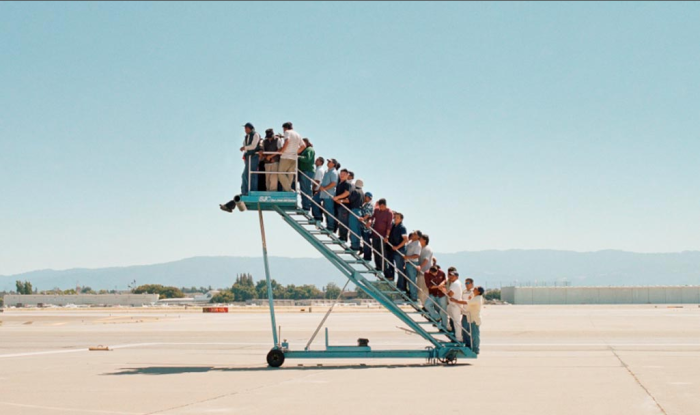
Adrian Paci Centro di Permanenza Temporanea (2007)
Anri Sala was born in Tirana in 1974. He completed his studies at the Arts Academy of Tirana in 1996 before moving to Paris where he continued his studies at the National School of Decorative Arts and after at the National Studio of Contemporary Arts. Sala, like Paci, is best known as a video artist and began to fully harness this medium in his work around the same time as Paci in the late 1990s. He made his first video work in 1997 entitled Interview – Finding the Words. The 25 minute film features footage of a black and white video Sala found of his mother speaking at a youth movement of the Socialist Party in the 1970s. There is no sound in the original film so Sala tried to restore the missing speech in the film via the aid of a deaf-mute lipreader. When he plays the film to his mother with the reconstructed speech she is embarrassed with her language yet doesn’t distance herself from her socialist beliefs or associating herself with a political movement. The Albanian art writer and critic Stefan Capaliku explains how Sala, ‘enters between the (lost) voice and the (found) figure of his mother, someone who has lived both during communism and political pluralism. He interferes via the reconstruction of lost time, connecting two antagonistic moments.’
Subsequent films made by Sali include, Byrek (2000), which is a 24 minute video showing a traditional Balkan dish, byrek, being made with the recipe written in Albanian on the middle of the screen and Time After Time (2003). His film Give Me The Colours (Dammi i colori) was exhibited at the Tate Modern in London and in 2011, he had a high profile solo exhibition at the Serpentine Galleries.

Anri Sala Byrek (2000)
Whilst in Tirana I tried to locate some of the art spaces in the city which play an essential role in the city’s art scene. Unhappily I didn’t have much luck. On first impressions it seemed that I had perhaps overestimated the possibility of a thriving creative hub in the city. One place I very much wanted to visit, the Tirana Institute of Contemporary Art (T.I.C.A) was no longer in operation when I visited Tirana in December of last year. Considering that T.I.C.A, founded in 2002, was the first center for contemporary art in Tirana and has played a leading role in developing contemporary art in Albania, this was not a good sign. Another art space The Tirana Arts Lab appeared to be in operation and when I visited its webpage an exhibition was taking place, but it seemed to be permanently closed whenever I tried to enter. I later learnt that the owners were away in Germany. Furthermore, I had no luck in finding the Tirana Ekspress cultural centre.

The National Art Gallery of Albania
Yet my stay in Tirana was by no means fruitless. The National Art Gallery of Albania was all in working operation. Situated by the entrance to the museum is a modern white grid installation entitled The Cloud Pavilion designed by Sou Fujimoto. There are over 5000 works of art in the collection. Inside there is a modest room on the ground floor with paintings of portraits and street scenes from the first half of the 20th century. On the next level there are more, larger paintings which are historical and political in subject matter. Surprisingly when I was visiting, there was a large temporary exhibition by Grayson Perry featuring a series of tapestries inspired by the 18th century British artist William Hogarth’s series of works, ‘A Rake’s Progress’.
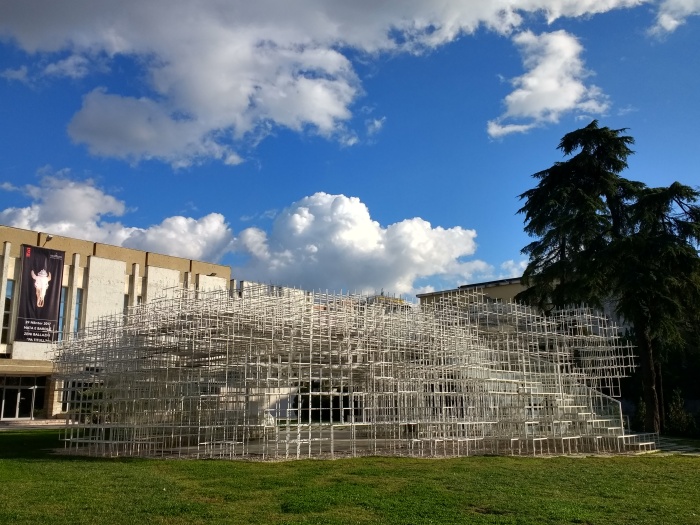
Sou Fujimoto The Cloud Pavilion
In addition to the Perry exhibition was another temporary in the museum by an Albanian, Kosovo based, artist called Zeni Ballazhi with a body of work across a range of different media. One work features a gilded framed photograph of the skull of an ox with a crown on its head. In another corner of the exhibition is a video projector projecting distorted footage of a human skull x-ray. Elsewhere is a room full of newspapers with a lone car tyre. Ballazhi’s art constantly questions who we are and our relationship with the world. He explains his art as follows; ‘Through artistic creation I seek to rebuild human soul unity, to replenish that soul with energy and tension, in order to transform my relationship with the world. Art addresses the need to introduce all living elements to the world, to enable them to communicate amongst each other, without privileges or hierarchy’.
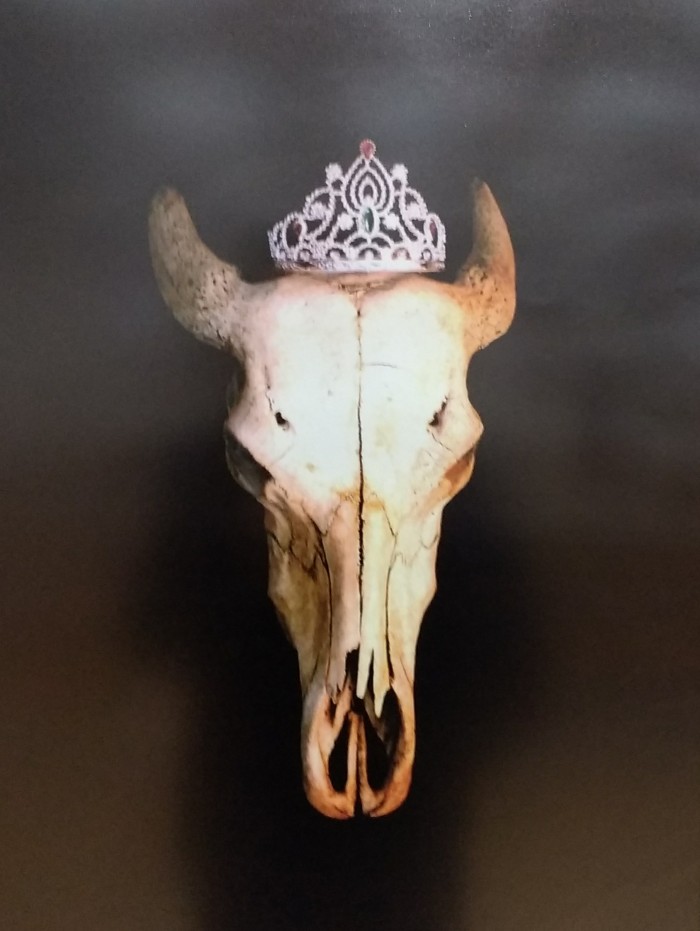
Zeni Ballazhi The smile of a fake life (2014)
From the National Art Gallery I walk towards the trendy Blloku district located south of the Lana River. On the way I walk past the iconic ‘Pyramid of Tirana’. It once served as the mausoleum for Enver Hoxha until 1991. Today it is derelict and neglected. Ample amounts of graffiti can be found and you can sometimes witness young locals playing on top of the structure.

Pyramid of Tirana
In the Blloku district, I visit a small commercial art gallery called the Kalo Gallery featuring a solo photography exhibition entitled North Korea’s Choreography of Happiness by a Tirana based photographer called Alfred Diebold. The exhibition comprises of photographs Diebold took when he visited North Korea. His photographs offer a fascinating glimpse into a country, virtually off limits to almost all outsiders. The only way to visit this country is as part of a guided tour and even in such a situation one is under immense scrutiny. In spite of these restrictions and limitations, Diebold captures North Korean society debased from some of the propaganda around the country. For example, one photograph shows a group of three locals having a picnic in some park with a greater variety of food than one would expect reading about from such a part of the world. In the photograph I see chicken, bread, apples and some salads too, as opposed to say Oliver Twist style gruel slop.
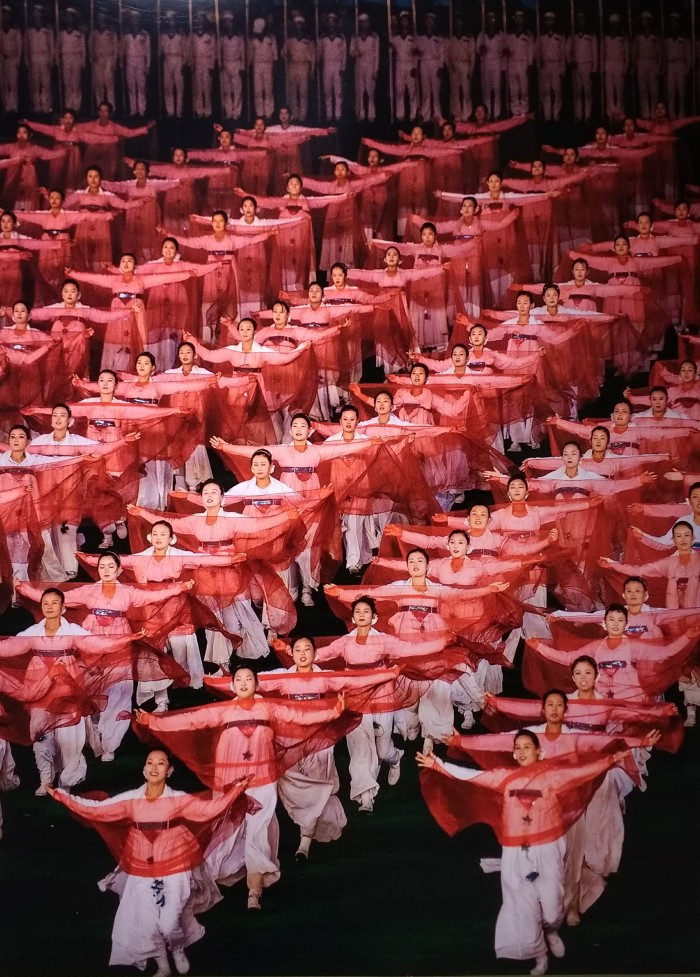
Photograph taken by Alfred Diebold whilst in North Korea
On the same street is another gallery called the Fab Gallery featuring a solo exhibition by Ardian Isufi entitled Flower Power. The highlight works in this small exhibition space are the large triptych paintings with themes of nature and destruction using bold and lavish amounts of blue, purple and red.

Ardian Isufi The Garden Of Permanent Instability (2016)
The highlight, however, of my time investigating Tirana’s scene involved a meeting the curator and gallery owner Valentina Koca who is a very important figure in the Albanian contemporary art scene and a tireless promoter of promising Albanian contemporary artists via her gallery space, Zeta. Since it was established just over ten years ago, it has played an integral and crucial role in showcasing the works of some of the most gifted Albanian artists. The history of the gallery and all its exhibitions are documented in a handsome hardback book, ‘Zeta: 2007-16’, published in 2016. Nineteen Albanian artists are represented in the book. Albanian modern artist Edi Hila, whom I mentioned earlier, is featured. In fact he has already exhibited three times at the gallery. In the book there are colour photographs of four paintings by Hila; two of which are from 1975. His water colour from that year, Under the Sacks, reminds me of the artist Marc Chagall sharing his loose, surreal and introspective qualities. Each show by Hila at Zeta was curated by Zef Paci, who is an art history professor at the Tirana Academy of Art. One afternoon I met Zef along with Valentina for coffee and tea at a local café in the city. We spoke at length about the history of Albanian art as well as the current art scene in Tirana and the future of the city and Albania in general.

Edi Hila Under The Sacks (1975)
Other Albanian artists in the Zeta book who’s works intrigue me include Albana Shoshi, Enkelejd Zonja and Ervin Berxolli. Shoshi’s painting At The Sea (2008) comprises of a large Albanian family on the beach with two towels suspended from the parasol; of which one represents the flag of the European Union and the other the flag of Albania. On one hand this is a typical painting of an Albanian family on the beach. Yet this is also a political painting too. Albania is not a member of the European Union yet it shares a border with a country that is, Greece. Furthermore, when this painting was created in 2008, the cracks and struggles that the European Union is currently grappling with, had yet to come to the fore.

Albana Shoshi At The Sea (2008)
Enkelejd Zonja is a mixed media artist yet its his hyper realist paintings, which interest me. One of these paintings, In Your Vein (2011), is inspired and influenced by a painting by the Italian master Caravaggio depicting the former Albanian dictator Enver Hoxha pulling up his shirt and vest to expose his right nipple whilst simultaneously grabbing the hand of a member of the public, as if it is imitating a pistol with one finger piercing a deep wound in his torso. It is a painting of high drama and very human with each subject painted in a sensitive and realistic way with no exaggerated mannerism. The three subjects in the painting next to Enver are representations of the so called ‘common man’ and are each painted in a style, which donates to the painting a strong sense of gritty realism; this is the aspect of the painting, which shines for me and I am reminded of another painting by Caravaggio; his 1601 painting Supper At Emmaus in the London National Gallery capturing Jesus with two of his disciples who are both depicted very acutely in all their hardcore material poverty and humanism. The man with his hand under Enver’s grip is dressed in dirty, well-worn and little washed cloths; he could be a factory worker, builder or metal welder perhaps. The older man to his right with his head hunched down appears down and out and downtrodden with a face revealing someone who’s ridden through the heavy grime and rough ride of life and has subsequently been severely conditioned and affected by his experiences.

Enkelejd Zonja In Your Vein (2011)
Ervin Berxolli is also a mixed media artist and in the book there are two photographs of prints on wood entitled From The Cycle Icons (2014). In these works I am reminded of seminal experimental black and white photographs I witnessed in the collection of the Marubi museum in Shkodra. The distortions, various marks and manipulations augment the metaphysical qualities of the works and small discerning nuances morph into something more pronounced and take on a greater role. They become haunting and hard to forgot.

Ervin Berxolli From The Cycle Icons (2014)
There is more to Tirana than what at first meets the eye, but through perseverance and an unyielding curiosity the city and its secrets will slowly be revealed.
By Nicholas Peart
©All Rights Reserved
REFERENCES
Articles
frieze.com/article/mother-country
frieze.com/article/article/adrian-paci
frieze.com/article/article/anri-sala
Books
Stefan Capaliku – On Albanian Contemporary Art (2014)
Zeta 2007 – 2016 (2016)
I was lucky to visit some of these places Nick, a fascinating part of the world. You’ve investigated fully the museums and art that was on offer. I went to some of these galleries etc and felt a little underwhelmed with what was on offer, it looks like I missed a lot of interesting exhibitions. I especially like that painting by Adrian Isufi. I think my favourite art was in the orthodox Christian churches. Beautiful. Great post Nick!
LikeLiked by 1 person
Glad you enjoyed the post Lee and many thanks for your kind words. Albania/Kosovo is a little under the radar in terms of its contemporary art scene and many contemporary Albanian artists live abroad. Some art spaces were sadly not in operation when I visited Tirana, but on the other hand I was also lucky with a lot of my findings too.
LikeLiked by 1 person